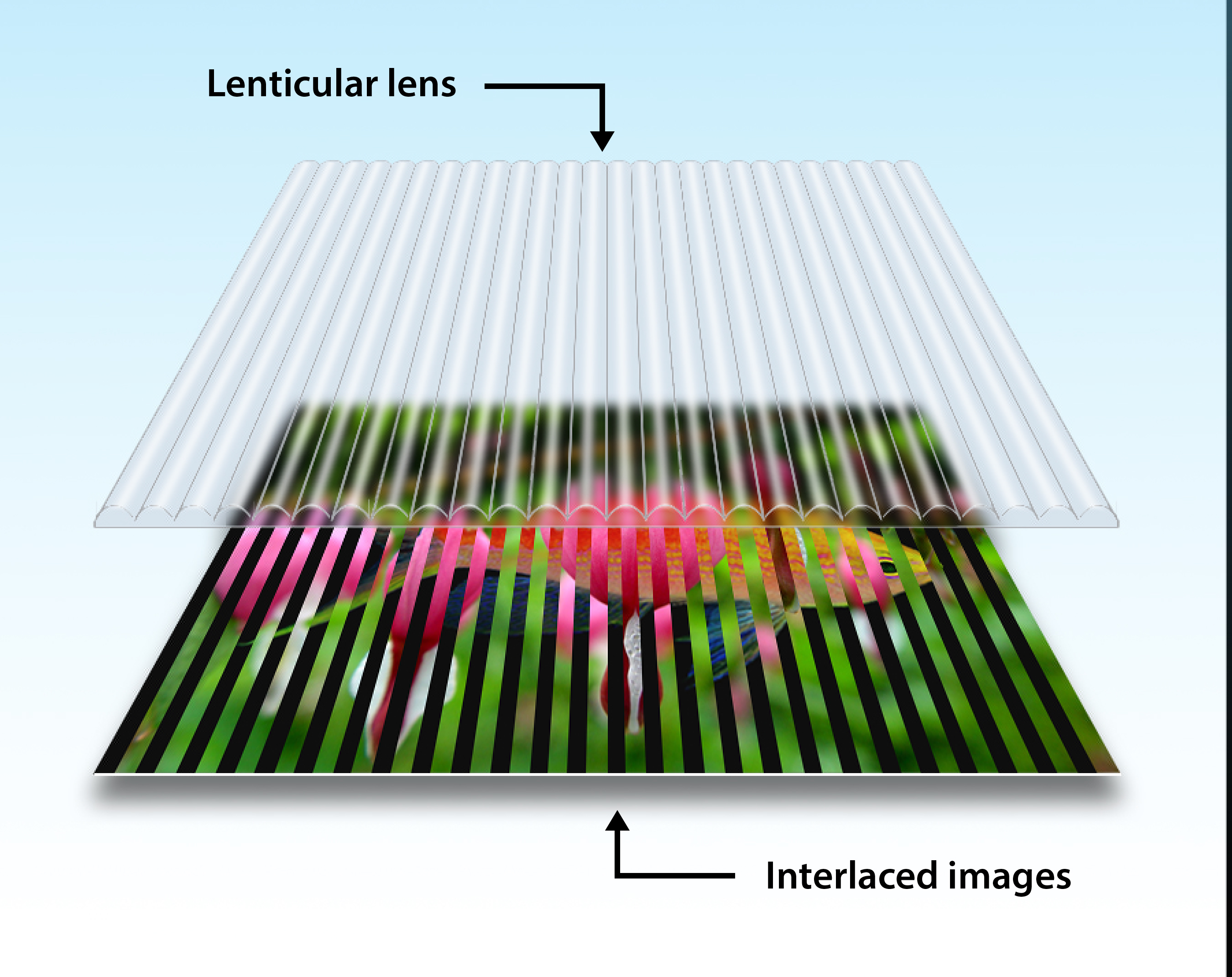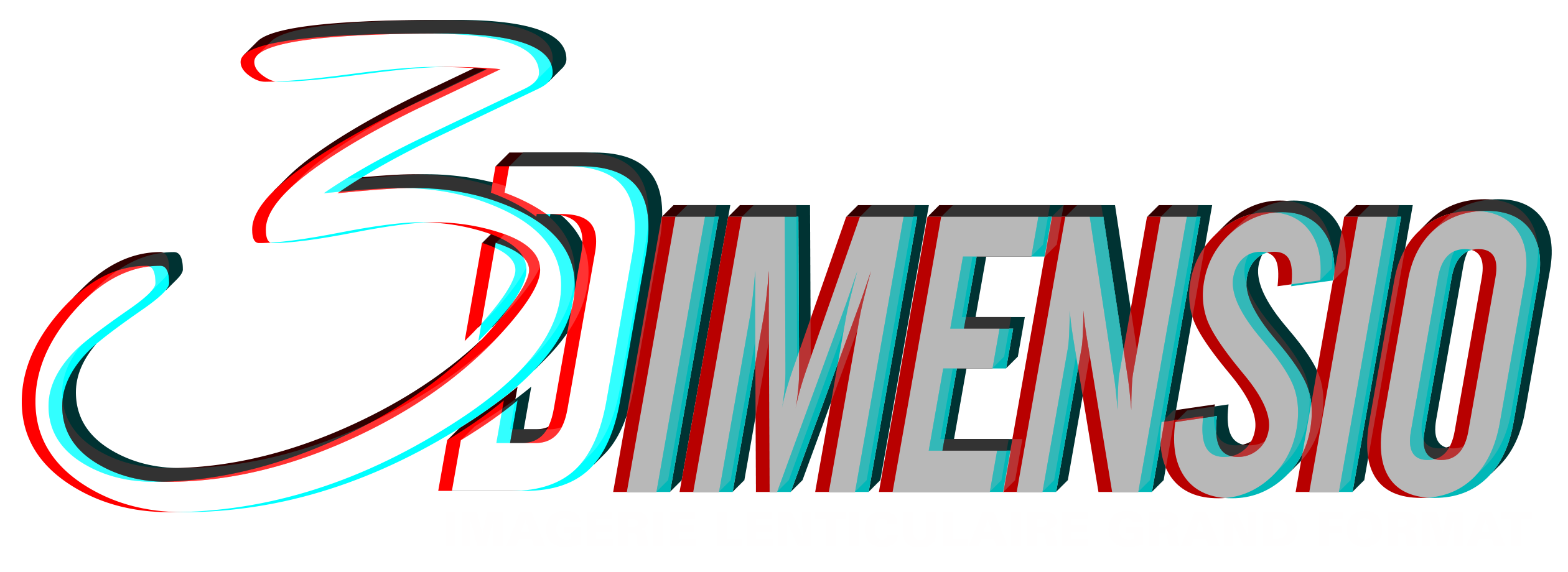 The lenticular sheet
The lenticular sheet
The lenticular sheet (also called "lenticular network") is composed
ofcylindrical or spherical lenses with the same optical
characteristics, the lenticules, which have the particularity of having
a focal length such as the back face (the smooth face) of the
lenticular sheet is confused with the focal plane of the lenses.
The cylindrical lenses are parallel to each other while the spherical
lenses are organized checkerboard or honeycomb. Each lenticule
enlarges one pixel of an image on the smooth face of the lenticular
sheet, the pixel that is located in line with the eye and the optical
center of the lenticule. It then takes the color of this pixel. The two
eyes of a spectator being located at different locations, they are
locatedin different alignments with respect to each lenticule, which
allows to give an impression of relief, except in the case of
cylindrical lenses arranged horizontally (parallel to the axis that
goes from one eye to the other).
With lenticular cylindrical lens arrays, the lenses are arranged vertically to produce a 3D effect. To display animations, we often prefer to
arrange them horizontally to avoid the artifacts coming from the fact that the two eyes of the viewer see different images, but when we
want the animation to be seen by a spectator moving horizontally, we have them vertically, being careful that there are not too many 3D
involuntary effects.
With lenticular networks with spherical lenses, we obtain a modification of the image seen as well for a horizontal movement as for a
vertical movement of the spectator.
In any case, the image must be perfectly aligned with the lenses. The lenticular sheet is a transparent and stable substrate,with smooth
surface that allows to apply the image by direct printing (offset) or against gluing and in perfecalignment with the lenses. The image must
be made to match perfectly with the measurement of the lenses.
Origin
Any lenticular effect is composed of at least two images of the same size. For example ;a 2-position flip (laughing clown, crying clown)
consists of two images that are exactly the same size. An animation may include more images, such as a video clip or sequential pictures.
With cylindrical lenticular lens networks, the number of images viewed successively is equal to the width of a lens divided by that of a pixel
of the interlaced image. The best printers, reaching a resolution of 4800 DPI(pixels per inch), thus obtain 120 visible images through a
lenticular network at 40 LPI (40 lenses per inch). With lenticular spherical lens networks, the number of images is almost doubled.
A relief image requires at least two different images, but the relief is all the more important as we multiply the number of images, they
can be photographed by moving the camera laterally or using a camera with several goals.
Another method is to create layered elements with software, which are then moved to obtain an artificial parallax effect on the images.
The effets
*Relief or 3D
The 3D effect offers an effect of depth always surprising. The elements of the visual are positioned on several spatial planes so as to
create the illusion of a third dimension. The perception othe right eye differs from that of the left eye, which allows the brain to
recompose a three-dimensional image.
*Animation
Animation is a sequence of images corresponding to the complete range of the expression of a movement or the progressive
transformation of an object into another (Morphing) or of its enlargement and reduction (Zooming) or of 2 or 3 completely different
pictures (Flip).
The animation proposes a movement of the image which, according to the number of sequences, can appear continuous. From
successive images or video sequences, we try to reproduce the fluidity of an animated film. From 15 to 400 images can compose an
animated lenticular visual.
Lenticular impression
The most common method, (more than 90% of lenticular images in the world) is offset lithographic printing. CTP films or plates of very
high resolution. The plates must allow a perfect registration of the four colors in press. The offset press will preferably have 6 colors to be
able to apply the white cover in one pass. The mechanical condition of the presses to print the lenticular is essential. The registration of
colors must be maintained on the order of 1/500 mm for certain works, and the alignment of the image with the lenses must be
maintained with the most critical tolerance to arrive at the best possible result. New presses from different manufacturers are able to
provide a superior quality result.
Usually a more opaque white is needed once the inks are dry; There are several methods for this: UV inks, screen printing, laminating
with polypropylene film or paper. When printing white in lithography it is recommended to apply several benches to obtain better opacity. The use of UV dryers will increase opacity,
coverage and scratch resistance. It is also possible to print another visual on the back of the lenticular image, over the white covering, in
this case the opacity is essential to not have ghosts on one side or the other.
Large Format Printing
Large format prints are images of about 1 square meter. The lenticular plastic used is often
thicker than that used for small formats such as postcards. The plates have a maximum dimension of 1.2 × 2.4 m and a
thickness varying from 0.6 to 4 mm approximately. Offset is now used for campaigns with several hundred posters, but
large format remains the domain of inkjet for smaller quantities. The images obtained have a very important impact,
the relief obtained is about 5 times larger than that obtained with the best lenticular sheets for off-set printing.
There are two printing processes, the first is to use flatbeds. The lenticular plate is printed directly on this type of flatbed printer.
The second method is to use a high-definition inkjet printer. The resulting print is manually laminated with a laminator under the
lenticular plate with a tenth of a millimeter accuracy over the entire surface. The best results are achieved with high definition inkjet
prints. Indeed the best flatbeds have ink drop sizes of the order of ten picolitre while the best inkjet have a drop size of picoliter order.
The lenticular plastic magnifying glass 10 times, the points of the high definition prints are invisible, which is not the case for direct
impressions in flatbed. Lenticular plates can be connected to make much larger images, but it is not easy to succeed. The manufacturing
constraints are then extreme to maintain a registration of the order of one tenth of a mm on all plates to be connected. A 4 X 3m is even
feasible on the condition that the spectators are prevented from approaching, which would not be compatible with the optical
characteristics of a lenticular network. Large format lenticular prints have a prominent place whenever the situation requires significant
impact.
 The lenticular sheet
The lenticular sheet
